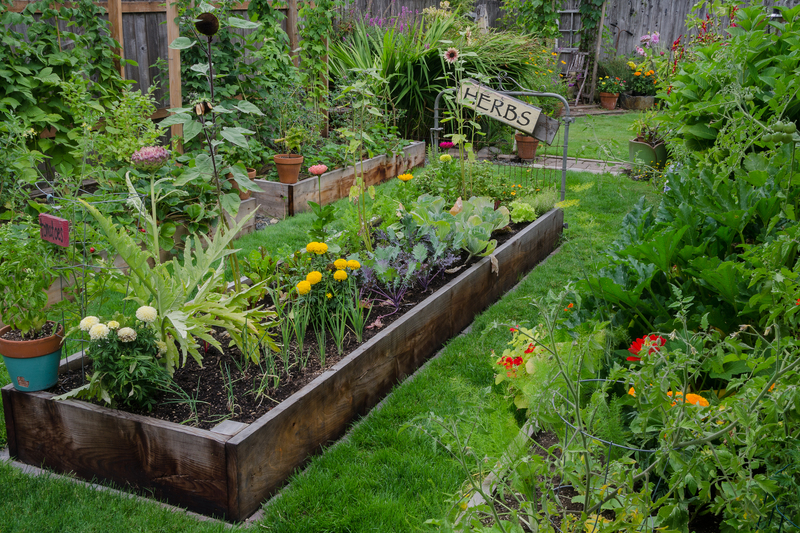Winter Plant Protection: Shielding Your Flora from the Frost
Posted on 12/09/2025
Winter Plant Protection: Shielding Your Flora from the Frost
Winter can be both enchanting and challenging for garden enthusiasts. The gentle hush of snow and the crisp, cold air create a stunning landscape, but these same conditions can wreak havoc on your cherished flora. Winter plant protection is crucial for maintaining the health and beauty of your garden, ensuring your beloved plants survive and thrive through the coldest months.
Why Winter Plant Protection Matters
During winter, flora face several threats, including frost damage, dehydration, fluctuating temperatures, windburn, and animal interference. These factors can significantly weaken or even kill unprotected plants. Providing adequate winter protection not only shields your greenery from immediate harm but also guarantees a vigorous revival in spring.
The Science Behind Winter Damage
- Freezing Temperatures: When water inside plant cells freezes, it expands, causing cell walls to rupture and resulting in wilted or blackened foliage.
- Desiccation: Cold winds can sap moisture from leaves, leading to winter burn, especially on evergreens.
- Soil Heaving: Freeze-thaw cycles can push plant roots upward, exposing them to lethal cold.
- Pest and Animal Issues: Hungry rodents and deer may feast on unprotected bark and stems.

Preparing Your Garden for Winter's Chill
To ensure robust winter garden protection, preparation is vital. Early planning allows your plants to acclimate and strengthens their resilience. Here's how you can get your garden ready for the winter freeze.
1. Assess Your Flora
- Identify sensitive and hardy species. Tender plants such as tropicals, tender perennials, and young saplings require the most attention.
- Note the plant's location, microclimate, and exposure levels.
2. Clean Up and Prune Appropriately
- Remove diseased leaves and debris that could harbor overwintering pests.
- Prune only as needed. Late pruning can encourage new growth that's vulnerable to frost damage.
3. Amend and Mulch Soil
- Enrich soil with compost to encourage root health.
- Apply a thick layer of mulch (2-4 inches) around roots, but keep it away from the plant stem. Mulch regulates soil temperature, prevents heaving, and retains moisture.
Essential Techniques for Plant Frost Protection
There are numerous methods to shield your garden during winter, ranging from simple DIY solutions to specialized equipment. Here, we explore the most effective frost protection for plants.
Protective Coverings: The Direct Defense
Covering plants offers immediate insulation from sudden frosts and biting winds.
- Frost Blankets & Floating Row Covers: Lightweight, breathable fabric is draped over plants to trap heat. These can be left on for extended periods or overnight during freeze warnings.
- Burlap Sacks: Especially useful for wrapping shrubs and evergreens, burlap protects against windburn and ice buildup.
- Old Sheets or Cloth: In a pinch, old bedsheets or towels can offer emergency protection.
- Plastic Tunnels and Mini Greenhouses: These structures provide coverage while allowing sunlight penetration. Raise the plastic occasionally to prevent condensation and fungus.
Winter Mulching: Beyond Summer Mulch
Winter mulching works as an insulating barrier, protecting both roots and bulbs from extreme lows and thaws. Organic materials like straw, shredded leaves, pine needles, or wood chips are ideal. Pile mulch 2-4 inches thick around vulnerable plants once the ground is frozen, which helps lock in soil warmth accumulated in autumn.
Watering Wisely Before a Freeze
Moist soil retains heat better than dry earth, so adequate hydration before a hard freeze offers natural frost plant protection. But avoid waterlogging, as soggy soil can lead to root rot.
- Water deeply during late autumn, especially during dry spells.
- Avoid watering during freeze alerts to prevent ice buildup around the roots.
Windbreaks and Physical Barriers
Constructing simple windbreaks can buffer your garden against harsh, dehydrating winter winds. Use fences, temporary screens, or even a row of straw bales on the windward side.
Specialized Winter Protection for Different Plant Types
Each plant group needs tailored winter plant care to ensure survival and seasonal recovery.
Evergreens
- Apply anti-desiccant sprays to reduce needle and leaf moisture loss.
- Wrap with burlap or apply shade cloth to prevent sunscald and windburn.
- Protect young evergreens with windbreaks, especially in exposed locations.
Perennials
- Cut back stems after hard frost, leaving several inches for insulation.
- Cover crowns with loose mulch or inorganic materials like pine needles.
Roses
- For hybrid teas and shrub roses, mound soil or compost around the base before applying mulch or straw.
- Use rose cones or burlap wraps for extra protection in extremely cold areas.
Tender Bulbs and Tropicals
- Dig up and store bulbs like dahlias, cannas, and caladiums indoors once foliage withers.
- House potted tropicals indoors, providing bright light and humidity.
Safeguarding Container Plants in Winter
Potted plants are more susceptible to cold due to limited soil mass and exposure. Here's how to enhance winter protection for container plants:
- Move pots to sheltered locations, such as south-facing walls, garages, or porches.
- Elevate and group containers for extra warmth.
- Enroll containers in insulated wraps with bubble wrap, burlap, or garden fleece.
- Water sparingly; do not allow soil to dry completely or become waterlogged.
Advanced Strategies for Extreme Winters
For those in regions with harsh, prolonged winters, standard protective measures may need extra reinforcement.
Heat-Lamps & String Lights
- Non-LED string lights can add a few degrees of warmth under covers for tender and young plants.
- Carefully monitor to avoid any fire hazards and only use outdoor-rated equipment.
Cloche Domes & Cold Frames
- Use glass or plastic cloches for individual plants.
- A cold frame offers a mini greenhouse environment, perfect for hardy greens.
Snow as Natural Insulation
A consistent layer of snow acts as nature's blanket, insulating plants from deeper frosts. Avoid shoveling snow onto sensitive shrubs where the weight could cause breakage. On dry days, gently brush snow off evergreens to prevent branch snapping.
Common Mistakes to Avoid in Winter Plant Care
Effective winterizing means knowing what not to do, as well as what to do. The following are common missteps:
- Pruning too late: Late trimming encourages soft new growth susceptible to frostbite.
- Using plastic directly on plants: Plastic traps moisture and heat, which can result in mold and fungal issues as well as tissue burn.
- Over-mulching: Excess mulch (more than 4 inches) can foster rot and rodent nesting.
- Improper watering: Letting soil dry out or overwatering both spell trouble.
Eco-Friendly Winter Plant Protection Ideas
Sustainable gardening doesn't end in winter. Implement eco-friendly frost protection methods with these tips:
- Use organic and biodegradable mulching materials whenever possible.
- Repurpose household items, like old blankets or plant pots, for temporary cover.
- Encourage a balanced winter ecosystem by providing shelter for beneficial insects in brush piles or purpose-built bug hotels.
Monitoring and Maintenance During Winter
Regular garden checks are essential to maintaining effective winter plant protection. After snowstorms or freezes:
- Inspect and readjust covers as needed.
- Remove excess snow from branches for safety.
- Check for signs of desiccation, rodent damage, or unusual browning.
- Remove or refresh mulch if it becomes compacted or waterlogged.

Emerging Technologies in Frost Plant Protection
Innovations in the gardening world are making winter plant safety more effective and convenient.
- Smart Plant Sensors: These devices monitor soil moisture, temperature, and humidity, alerting you to risky conditions.
- Biodegradable Insulating Wraps: Easily composted in spring, they offer eco-conscious gardeners another tool.
- Mobile Shelters: Modular greenhouse tents can be set up quickly and moved as required.
Conclusion: Providing Comprehensive Winter Plant Protection
Successfully shielding your flora from frost involves understanding your plants' needs, local climate, and the best combination of traditional and modern protective techniques. Proper winter plant care allows you to rest easy during the coldest days of the year, ensuring your garden remains healthy and primed for spring resurgence.
By adopting these winter garden protection strategies-- from diligent mulching to innovative covers-- you'll not only prevent winter woes but foster a landscape that returns more vibrant than ever. Remember, a little effort now reaps rewards for seasons to come.

